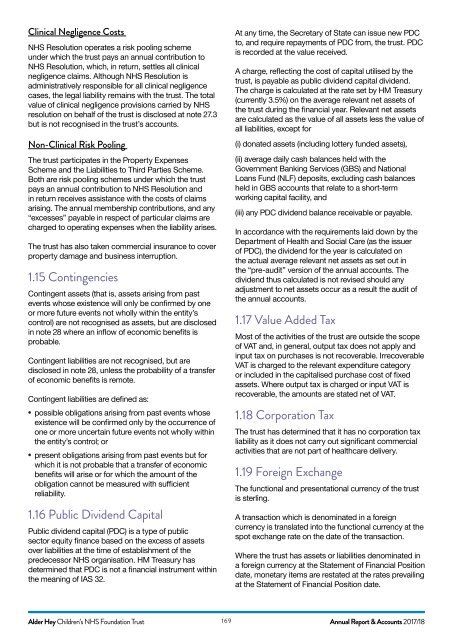AH ANNUAL REPORT 2018
Create successful ePaper yourself
Turn your PDF publications into a flip-book with our unique Google optimized e-Paper software.
Clinical Negligence Costs<br />
NHS Resolution operates a risk pooling scheme<br />
under which the trust pays an annual contribution to<br />
NHS Resolution, which, in return, settles all clinical<br />
negligence claims. Although NHS Resolution is<br />
administratively responsible for all clinical negligence<br />
cases, the legal liability remains with the trust. The total<br />
value of clinical negligence provisions carried by NHS<br />
resolution on behalf of the trust is disclosed at note 27.3<br />
but is not recognised in the trust’s accounts.<br />
Non-Clinical Risk Pooling<br />
The trust participates in the Property Expenses<br />
Scheme and the Liabilities to Third Parties Scheme.<br />
Both are risk pooling schemes under which the trust<br />
pays an annual contribution to NHS Resolution and<br />
in return receives assistance with the costs of claims<br />
arising. The annual membership contributions, and any<br />
“excesses” payable in respect of particular claims are<br />
charged to operating expenses when the liability arises.<br />
The trust has also taken commercial insurance to cover<br />
property damage and business interruption.<br />
1.15 Contingencies<br />
Contingent assets (that is, assets arising from past<br />
events whose existence will only be confirmed by one<br />
or more future events not wholly within the entity’s<br />
control) are not recognised as assets, but are disclosed<br />
in note 28 where an inflow of economic benefits is<br />
probable.<br />
Contingent liabilities are not recognised, but are<br />
disclosed in note 28, unless the probability of a transfer<br />
of economic benefits is remote.<br />
Contingent liabilities are defined as:<br />
• possible obligations arising from past events whose<br />
existence will be confirmed only by the occurrence of<br />
one or more uncertain future events not wholly within<br />
the entity’s control; or<br />
• present obligations arising from past events but for<br />
which it is not probable that a transfer of economic<br />
benefits will arise or for which the amount of the<br />
obligation cannot be measured with sufficient<br />
reliability.<br />
1.16 Public Dividend Capital<br />
Public dividend capital (PDC) is a type of public<br />
sector equity finance based on the excess of assets<br />
over liabilities at the time of establishment of the<br />
predecessor NHS organisation. HM Treasury has<br />
determined that PDC is not a financial instrument within<br />
the meaning of IAS 32.<br />
At any time, the Secretary of State can issue new PDC<br />
to, and require repayments of PDC from, the trust. PDC<br />
is recorded at the value received.<br />
A charge, reflecting the cost of capital utilised by the<br />
trust, is payable as public dividend capital dividend.<br />
The charge is calculated at the rate set by HM Treasury<br />
(currently 3.5%) on the average relevant net assets of<br />
the trust during the financial year. Relevant net assets<br />
are calculated as the value of all assets less the value of<br />
all liabilities, except for<br />
(i) donated assets (including lottery funded assets),<br />
(ii) average daily cash balances held with the<br />
Government Banking Services (GBS) and National<br />
Loans Fund (NLF) deposits, excluding cash balances<br />
held in GBS accounts that relate to a short-term<br />
working capital facility, and<br />
(iii) any PDC dividend balance receivable or payable.<br />
In accordance with the requirements laid down by the<br />
Department of Health and Social Care (as the issuer<br />
of PDC), the dividend for the year is calculated on<br />
the actual average relevant net assets as set out in<br />
the “pre-audit” version of the annual accounts. The<br />
dividend thus calculated is not revised should any<br />
adjustment to net assets occur as a result the audit of<br />
the annual accounts.<br />
1.17 Value Added Tax<br />
Most of the activities of the trust are outside the scope<br />
of VAT and, in general, output tax does not apply and<br />
input tax on purchases is not recoverable. Irrecoverable<br />
VAT is charged to the relevant expenditure category<br />
or included in the capitalised purchase cost of fixed<br />
assets. Where output tax is charged or input VAT is<br />
recoverable, the amounts are stated net of VAT.<br />
1.18 Corporation Tax<br />
The trust has determined that it has no corporation tax<br />
liability as it does not carry out significant commercial<br />
activities that are not part of healthcare delivery.<br />
1.19 Foreign Exchange<br />
The functional and presentational currency of the trust<br />
is sterling.<br />
A transaction which is denominated in a foreign<br />
currency is translated into the functional currency at the<br />
spot exchange rate on the date of the transaction.<br />
Where the trust has assets or liabilities denominated in<br />
a foreign currency at the Statement of Financial Position<br />
date, monetary items are restated at the rates prevailing<br />
at the Statement of Financial Position date.<br />
Alder Hey Children’s NHS Foundation Trust 169<br />
Annual Report & Accounts 2017/18


